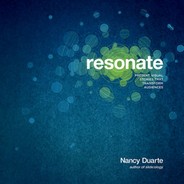86 Resonate
There’s no doubt about it; most people do not enjoy
change and will resist. An audience might understand
your plea, and even mentally accept it, but they still
might not be moved to action.
In the July 2008 issue of Harvard Business Review, John
P. Kotter and Leonard A. Schlesinger reported, “All peo-
ple who are affected by change experience some emo-
tional turmoil. Even changes that appear to be ‘positive’
or ‘rational’ involve loss and uncertainty. Nevertheless,
for a number of different reasons, individuals or groups
can react very differently to change—from passively
resisting it, to aggressively trying to undermine it, to
sincerely embracing it.”
4
Audience members will often push back or try to find
errors in your presentation because if they don’t, they
have to either live with the contradiction between their
old position and the new one you’ve “sold” them, or
opt to change. Their resistance could be as subtle as
skepticism or as destructive as a revolt, and you must
deal with it squarely. How do you modify your communi-
cation to move the audience from aggressively trying to
undermine your message to sincerely embracing it?
Carefully contemplate all the ways in which your audi-
ence might resist. What attitudes, fears, and limitations
do they use as a tool to oppose implementing the idea?
After identifying their reasons for refusal, use those
Address Resistance
Refusal of the Call
concerns as inoculants. State the opposing points before
they get a chance to refute your point.
An inoculation purposefully infects a person to minimize
the severity of an infection. The same takes place when
you empathetically address an audience’s refusals by stat-
ing them openly in your talk. This will help them see that
you’ve thought through everything—which will decrease
their anxiety.
Most people don’t resist simply for the sake of resis-
tance (although some do). Most resist because you’re
asking them to do something that requires them to
take a risk or make a sacrifice of a varying degree. For
example, asking people to buy a product could make
them feel as if they are risking their reputations by
spending company money on a product with an unpre-
dictable outcome.
What you perceive as resistance may be viewed com-
pletely differently in the audience members’ minds.
They might resist your message because, from their
perspective, it puts their reputations, credibility, or
honor on the line. If the audience takes this stance with
your message, what you see as resistance they see as
valor. They are protecting the things they hold dear and
responding appropriately. Acknowledge their resistance
while simultaneously assuring them that they are in
good hands with you, their mentor.
CH004.indd 86CH004.indd 86 8/16/10 4:06:09 PM8/16/10 4:06:09 PM

Define the Journey 87
Refusal of the Call
COMFORT ZONE
What’s their tolerance
level for change? Where is
their comfort zone? How
far out of it are you asking
them to go?
FEAR
What keeps them up at
night? What’s their great-
est fear? What fears are
valid, and which should
be dispelled?
MISUNDERSTANDING
What might they misunder-
stand about the message,
the proposed change, or
the implications? Why
might they believe the
change doesn’t make
sense for them or their
organization?
OBSTACLES
What mental or practical
barriers are in their way?
What obstacles cause fric-
tion? What will stop them
from adopting and acting
on your message?
POLITICS
Where is the balance
of power? Who or what
has influence over them?
Would your idea create
a shift in power?
VULNERABILITIES
In which areas are
they vulnerable? Any
recent changes, errors,
or weaknesses?
CH004.indd 87CH004.indd 87 8/16/10 4:06:10 PM8/16/10 4:06:10 PM
..................Content has been hidden....................
You can't read the all page of ebook, please click here login for view all page.
